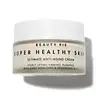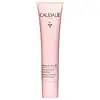What's inside
What's inside
 Key Ingredients
Key Ingredients

 Benefits
Benefits

 Concerns
Concerns

 Ingredients Side-by-side
Ingredients Side-by-side

Water
Skin ConditioningCaprylic/Capric Triglyceride
MaskingGlycerin
HumectantCoco-Caprylate/Caprate
EmollientButylene Glycol
HumectantEthylhexyl Palmitate
EmollientArachidyl Alcohol
EmollientGlyceryl Stearate
EmollientPEG-100 Stearate
Dimethicone
EmollientBehenyl Alcohol
EmollientPhenoxyethanol
PreservativeCarbomer
Emulsion StabilisingPropanediol
SolventOryza Sativa Hull Powder
AbrasiveArachidyl Glucoside
EmulsifyingTocopheryl Acetate
AntioxidantChlorphenesin
AntimicrobialMica
Cosmetic ColorantCI 77891
Cosmetic ColorantAvena Sativa Kernel Extract
AbrasiveSodium Hydroxide
BufferingVp/Va Copolymer
Hydrolyzed Hyaluronic Acid
HumectantSodium Hyaluronate
HumectantParfum
MaskingO-Cymen-5-Ol
AntimicrobialAsparagus Officinalis Stem Extract
Skin ConditioningTetrasodium Glutamate Diacetate
Isomalt
HumectantLeontopodium Alpinum Flower/Leaf Extract
Skin ConditioningAlgae Extract
EmollientSodium Benzoate
MaskingHydrolyzed Beta-Glucan
Skin ConditioningAlteromonas Ferment Extract
Skin ConditioningPhenethyl Alcohol
MaskingPotassium Sorbate
PreservativeLimonene
PerfumingBuddleja Davidii Leaf Extract
Skin ConditioningThymus Vulgaris Flower/Leaf Extract
MaskingDiacetyl Boldine
Skin ConditioningCalcium Gluconate
HumectantGluconolactone
Skin ConditioningRhododendron Ferrugineum Extract
MaskingNarcissus Tazetta Bulb Extract
AstringentCitric Acid
BufferingLinalool
PerfumingLecithin
EmollientVitis Vinifera Fruit Cell Extract
Skin ConditioningDisodium Phosphate
BufferingWater, Caprylic/Capric Triglyceride, Glycerin, Coco-Caprylate/Caprate, Butylene Glycol, Ethylhexyl Palmitate, Arachidyl Alcohol, Glyceryl Stearate, PEG-100 Stearate, Dimethicone, Behenyl Alcohol, Phenoxyethanol, Carbomer, Propanediol, Oryza Sativa Hull Powder, Arachidyl Glucoside, Tocopheryl Acetate, Chlorphenesin, Mica, CI 77891, Avena Sativa Kernel Extract, Sodium Hydroxide, Vp/Va Copolymer, Hydrolyzed Hyaluronic Acid, Sodium Hyaluronate, Parfum, O-Cymen-5-Ol, Asparagus Officinalis Stem Extract, Tetrasodium Glutamate Diacetate, Isomalt, Leontopodium Alpinum Flower/Leaf Extract, Algae Extract, Sodium Benzoate, Hydrolyzed Beta-Glucan, Alteromonas Ferment Extract, Phenethyl Alcohol, Potassium Sorbate, Limonene, Buddleja Davidii Leaf Extract, Thymus Vulgaris Flower/Leaf Extract, Diacetyl Boldine, Calcium Gluconate, Gluconolactone, Rhododendron Ferrugineum Extract, Narcissus Tazetta Bulb Extract, Citric Acid, Linalool, Lecithin, Vitis Vinifera Fruit Cell Extract, Disodium Phosphate
Water
Skin ConditioningCaprylic/Capric Triglyceride
MaskingIsostearyl Isostearate
EmollientCoco-Caprylate/Caprate
EmollientHeptyl Undecylenate
EmollientButylene Glycol
HumectantSilica
AbrasiveGlycerin
HumectantSqualane
EmollientCI 77891
Cosmetic ColorantGlyceryl Stearate Citrate
EmollientPotassium Cetyl Phosphate
EmulsifyingPalmitoyl Grapevine Shoot Extract
AntioxidantMica
Cosmetic ColorantPolyglyceryl-3 Stearate
EmulsifyingTocopheryl Acetate
AntioxidantBenzyl Alcohol
PerfumingHydrogenated Lecithin
EmulsifyingCaprylyl Glycol
EmollientXanthan Gum
EmulsifyingHydrolyzed Hyaluronic Acid
HumectantPolyacrylate Crosspolymer-6
Emulsion StabilisingAdenosine
Skin ConditioningDehydroacetic Acid
PreservativeAcetyl Dipeptide-1 Cetyl Ester
Skin ConditioningHyaluronic Acid
HumectantSodium Phytate
Khaya Senegalensis Bark Extract
Skin ProtectingMaltodextrin
AbsorbentTin Oxide
AbrasivePaeonia Lactiflora Root Extract
Skin ConditioningTocopherol
AntioxidantSodium Hydroxide
BufferingParfum
MaskingLinalool
PerfumingLimonene
PerfumingCoumarin
PerfumingWater, Caprylic/Capric Triglyceride, Isostearyl Isostearate, Coco-Caprylate/Caprate, Heptyl Undecylenate, Butylene Glycol, Silica, Glycerin, Squalane, CI 77891, Glyceryl Stearate Citrate, Potassium Cetyl Phosphate, Palmitoyl Grapevine Shoot Extract, Mica, Polyglyceryl-3 Stearate, Tocopheryl Acetate, Benzyl Alcohol, Hydrogenated Lecithin, Caprylyl Glycol, Xanthan Gum, Hydrolyzed Hyaluronic Acid, Polyacrylate Crosspolymer-6, Adenosine, Dehydroacetic Acid, Acetyl Dipeptide-1 Cetyl Ester, Hyaluronic Acid, Sodium Phytate, Khaya Senegalensis Bark Extract, Maltodextrin, Tin Oxide, Paeonia Lactiflora Root Extract, Tocopherol, Sodium Hydroxide, Parfum, Linalool, Limonene, Coumarin
Ingredients Explained
These ingredients are found in both products.
Ingredients higher up in an ingredient list are typically present in a larger amount.
Butylene Glycol (or BG) is used within cosmetic products for a few different reasons:
Overall, Butylene Glycol is a safe and well-rounded ingredient that works well with other ingredients.
Though this ingredient works well with most skin types, some people with sensitive skin may experience a reaction such as allergic rashes, closed comedones, or itchiness.
Learn more about Butylene GlycolThis ingredient is an emollient, solvent, and texture enhancer. It is considered a skin-softener by helping the skin prevent moisture loss.
It helps thicken a product's formula and makes it easier to spread by dissolving clumping compounds.
Caprylic Triglyceride is made by combining glycerin with coconut oil, forming a clear liquid.
While there is an assumption Caprylic Triglyceride can clog pores due to it being derived from coconut oil, there is no research supporting this.
Learn more about Caprylic/Capric TriglycerideCi 77891 is a white pigment from Titanium dioxide. It is naturally found in minerals such as rutile and ilmenite.
It's main function is to add a white color to cosmetics. It can also be mixed with other colors to create different shades.
Ci 77891 is commonly found in sunscreens due to its ability to block UV rays.
Learn more about CI 77891Coco-Caprylate/Caprate is created from fatty coconut alcohol, caprylic acid, and capric acid.
It is a lightweight emollient. Emollients create a thin barrier on the skin to trap moisture in. This helps keep your skin hydrated and soft.
Once applied, Coco-Caprylate/Caprate is absorbed quickly and leaves a silky feel.
Coco-Caprylate/Caprate may not be fungal acne safe.
Learn more about Coco-Caprylate/CaprateGlycerin is already naturally found in your skin. It helps moisturize and protect your skin.
A study from 2016 found glycerin to be more effective as a humectant than AHAs and hyaluronic acid.
As a humectant, it helps the skin stay hydrated by pulling moisture to your skin. The low molecular weight of glycerin allows it to pull moisture into the deeper layers of your skin.
Hydrated skin improves your skin barrier; Your skin barrier helps protect against irritants and bacteria.
Glycerin has also been found to have antimicrobial and antiviral properties. Due to these properties, glycerin is often used in wound and burn treatments.
In cosmetics, glycerin is usually derived from plants such as soybean or palm. However, it can also be sourced from animals, such as tallow or animal fat.
This ingredient is organic, colorless, odorless, and non-toxic.
Glycerin is the name for this ingredient in American English. British English uses Glycerol/Glycerine.
Learn more about GlycerinHydrolyzed Hyaluronic Acid is a form of hyaluronic acid. It is created by the hydrolysis of hyaluronic acid with a high molecular weight. Once created, Hydrolyzed Hyaluronic Acid has a low molecular weight.
Low molecular weight HA has been shown to hydrate and increase elasticity of the skin. Increasing elasticity is also associated with reduction of wrinkle depth.
One study found topical low molecular weight hyaluronic acid may be considered for the treatment of rosacea in the adult population. However, we always recommend speaking with a professional about your skin concerns.
Hyaluronic acids are a humectant. This means they draw moisture from the air. Hyaluronic acids help moisturize, soothe, and protect the skin.
Read more about other common forms of hyaluronic acid:
Learn more about Hydrolyzed Hyaluronic AcidLimonene is a fragrance that adds scent and taste to a formulation.
It's found in the peel oil of citrus fruits and other plants such as lavender and eucalyptus. The scent of limonene is generally described as "sweet citrus".
Limonene acts as an antioxidant, meaning it helps neutralize free radicals.
When exposed to air, oxidized limonene may sensitize the skin. Because of this, limonene is often avoided by people with sensitive skin.
The term 'fragrance' is not regulated in many countries. In many cases, it is up to the brand to define this term. For instance, many brands choose to label themselves as "fragrance-free" because they are not using synthetic fragrances. However, their products may still contain ingredients such as essential oils that are considered a fragrance.
Learn more about LimoneneLinalool is a fragrance and helps add scent to products. It's derived from common plants such as cinnamon, mint, citrus, and lavender.
Like Limonene, this ingredient oxidizes when exposed to air. Oxidized linalool can cause allergies and skin sensitivity.
This ingredient has a scent that is floral, spicy tropical, and citrus-like.
Learn more about LinaloolMica is a naturally occurring mineral used to add shimmer and color in cosmetics. It can also help improve the texture of a product or give it an opaque, white/silver color.
Serecite is the name for very fine but ragged grains of mica.
This ingredient is often coated with metal oxides like titanium dioxide. Trace amounts of heavy metals may be found in mica, but these metals are not harmful in our personal products.
Mica has been used since prehistoric times throughout the world. Ancient Egyptian, Indian, Greek, Roman, Aztec, and Chinese civilizations have used mica.
Learn more about MicaParfum is a catch-all term for an ingredient or more that is used to give a scent to products.
Also called "fragrance", this ingredient can be a blend of hundreds of chemicals or plant oils. This means every product with "fragrance" or "parfum" in the ingredients list is a different mixture.
For instance, Habanolide is a proprietary trade name for a specific aroma chemical. When used as a fragrance ingredient in cosmetics, most aroma chemicals fall under the broad labeling category of “FRAGRANCE” or “PARFUM” according to EU and US regulations.
The term 'parfum' or 'fragrance' is not regulated in many countries. In many cases, it is up to the brand to define this term.
For instance, many brands choose to label themselves as "fragrance-free" because they are not using synthetic fragrances. However, their products may still contain ingredients such as essential oils that are considered a fragrance by INCI standards.
One example is Calendula flower extract. Calendula is an essential oil that still imparts a scent or 'fragrance'.
Depending on the blend, the ingredients in the mixture can cause allergies and sensitivities on the skin. Some ingredients that are known EU allergens include linalool and citronellol.
Parfum can also be used to mask or cover an unpleasant scent.
The bottom line is: not all fragrances/parfum/ingredients are created equally. If you are worried about fragrances, we recommend taking a closer look at an ingredient. And of course, we always recommend speaking with a professional.
Learn more about ParfumSodium Hydroxide is also known as lye or caustic soda. It is used to adjust the pH of products; many ingredients require a specific pH to be effective.
In small amounts, sodium hydroxide is considered safe to use. However, large amounts may cause chemical burns due to its high alkaline.
Your skin has a natural pH and acid mantle. This acid mantle helps prevent harmful bacteria from breaking through. The acid mantle also helps keep your skin hydrated.
"Alkaline" refers to a high pH level. A low pH level would be considered acidic.
Learn more about Sodium HydroxideTocopheryl Acetate is AKA Vitamin E. It is an antioxidant and protects your skin from free radicals. Free radicals damage the skin by breaking down collagen.
One study found using Tocopheryl Acetate with Vitamin C decreased the number of sunburned cells.
Tocopheryl Acetate is commonly found in both skincare and dietary supplements.
Learn more about Tocopheryl AcetateWater. It's the most common cosmetic ingredient of all. You'll usually see it at the top of ingredient lists, meaning that it makes up the largest part of the product.
So why is it so popular? Water most often acts as a solvent - this means that it helps dissolve other ingredients into the formulation.
You'll also recognize water as that liquid we all need to stay alive. If you see this, drink a glass of water. Stay hydrated!
Learn more about Water